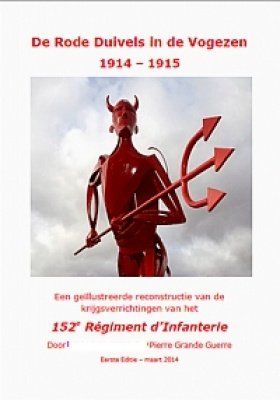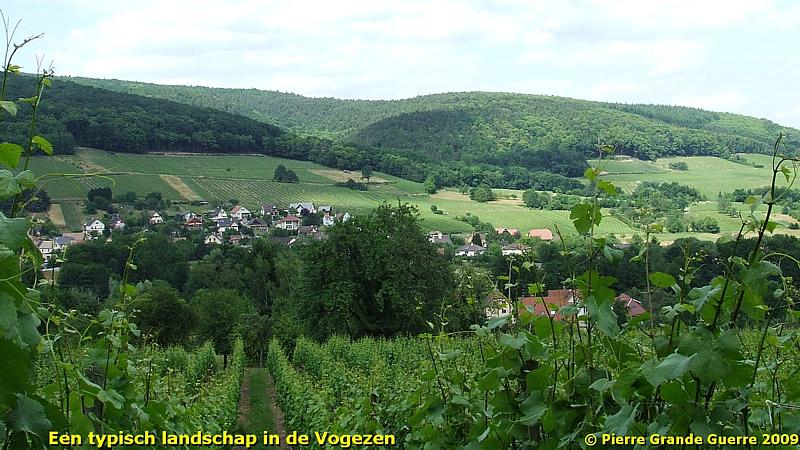The Difficult Start of the L.I.R. 123 - 1914-1915
Pierre's WFA-NL Lecture of 6 September 2014
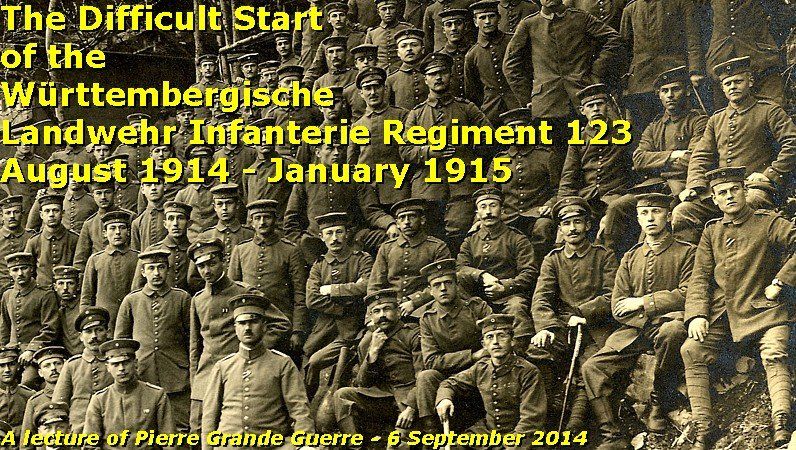
Introduction
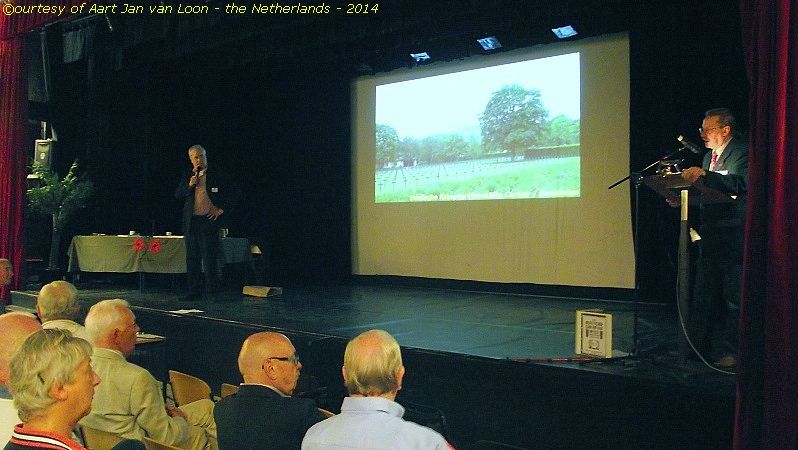
On 6 September 2014 I had the honour to address the audience of the Western Front Association of the Netherlands for the second time, this time with a lecture about
“The Difficult Start of the Württembergische Landwehr Infanterie Regiment 123 – August 1914 – January 1915” .
For the images I have of course made use of the projections, which I have used during my lecture. Photos from the collections of the L.I.R. 119, L.I.R. 121 ( Albums: Major Hermann and Jacob Sulan ) and LIR 123, are published with permission of Detlef Bussat, Expedition Hartmannsweilerkopf .
I have maintained the Dutch and German comments in the maps and images. With help of the accompanying lecture text, I am sure, that you will be able to understand the content of these comments.
I realize very well that the text deserves in many places some supplements, but I had to limit myself to a maximal speech time of 45 minutes. Incidentally, you will find many of the sub-topics also covered elsewhere, in the Vosges chapters here on my website, or these topics can be found in detail in the extensive survey of sources following after the end of the text of my lecture.
Dutch and Flemish visitors can read this lecture in their own language via this LINK .
Now I would like to present to you my lecture:

Short preface
Instead of the original German names of towns and villages, which were used in the Alsace region, I will use the current French names. Many German place names are still maintained today.
The photographs of the period, which I will show as illustration, were all taken in the region that is being discussed and show the units therein.
But the photos will not always correspond with the period that I will discuss today.
The “Armee-Abteilung Gaede”
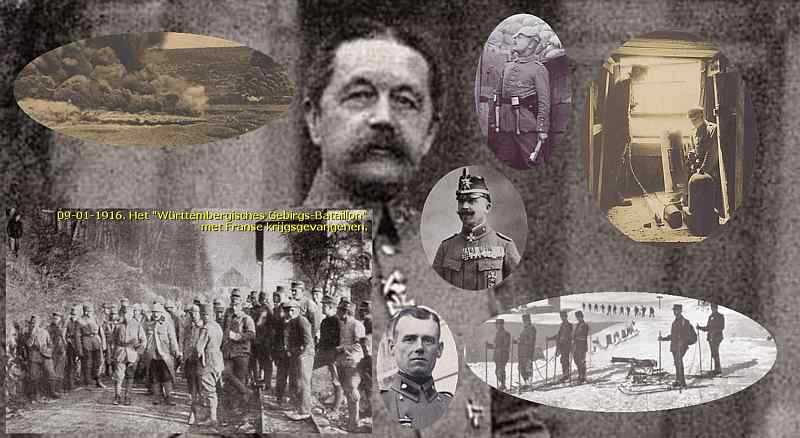
In my previous lecture of 28 April 2012, entitled " The Southern Vosges - Test Terrain of General Gaede ", I talked about the general situation in the Alsace region. I zoomed in on the well equipped and highly specialized fighting units of the "Armee-Abteilung Gaede" in the Vosges, among which were the elite mountain- and ski-combat units from Württemberg, the “Sturmabteilung“ units equipped with flamethrowers and a mortar company.
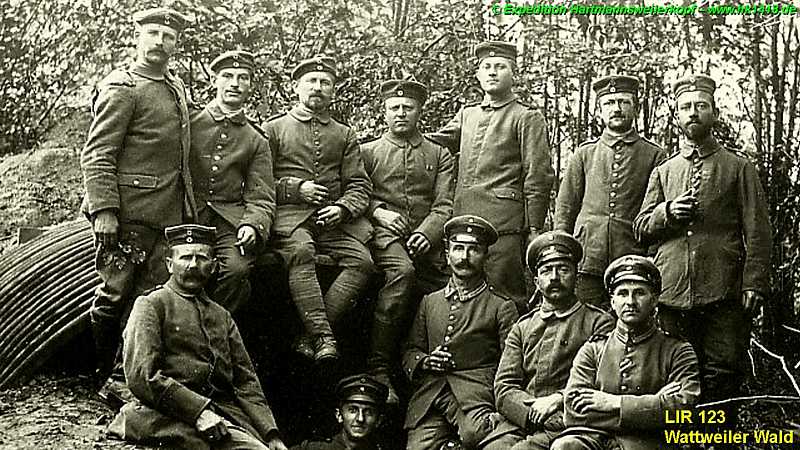
Still, from the beginning of the war, the Gaede army-group consisted mainly of regiments of older "Landwehr" soldiers, who were initially not so well trained nor were they as well equipped as these elite fighting units that arrived at the front some time later. The story of the "Württembergische Landwehr Infanterie Regiment 123” forms a good example of the experiences of all those other regiments of the Landwehr under the command of Gaede.
"Die Wacht am Rhein" (The watch on the river Rhine)

From 19 August 1914 onwards this regiment became part of the Army-corps Gaede. From then on until the armistice in November 1918 this regiment guarded Upper Alsace. Its situation is in stark contrast with that of the other elite units.
Start-up problems and shortages
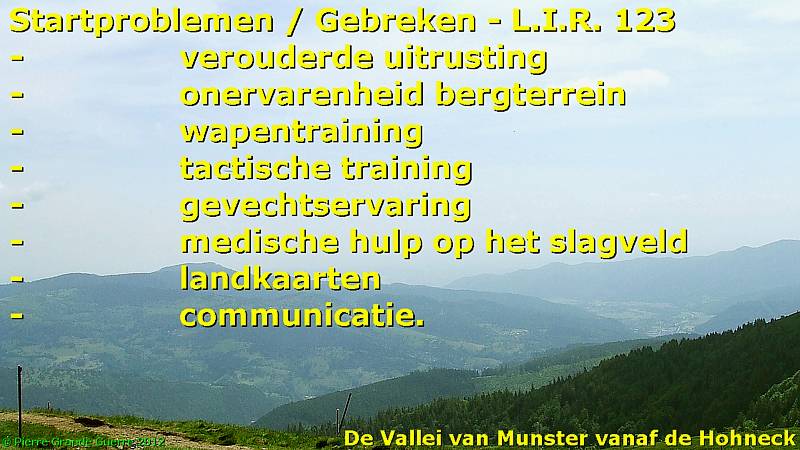
In this story I will try to show that men of the Landwehr experienced a very difficult start during the first six months of the war. The story of the 123rd Landwehr tells us not only of its successes but also of its many start-up problems and the many shortages it encountered. These problems were caused by outdated equipment, lack of experience in mountainous terrain, insufficient weapons training, no combat experience, no medical aid on the battlefield, too few and incorrect maps and bad communication. The situation of the 123rd can hardly be compared to other, better equipped units, which took part at the same time elsewhere in the execution of the scythe manoeuvre of the Von Schlieffenplan.
Sources
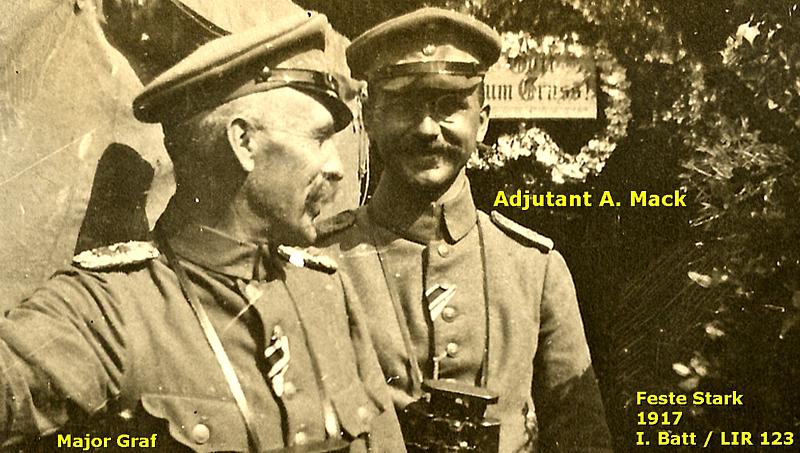
To form a picture about what this regiment went through, I turned to the history of the 123rd regiment as written by Prof. Dr. A. Mack. “This man ought to know”, one would assume at first instance, because during the entire war Mack was a member of this unit as "Bataillonsadjutant". But, this appears to be not altogether true.
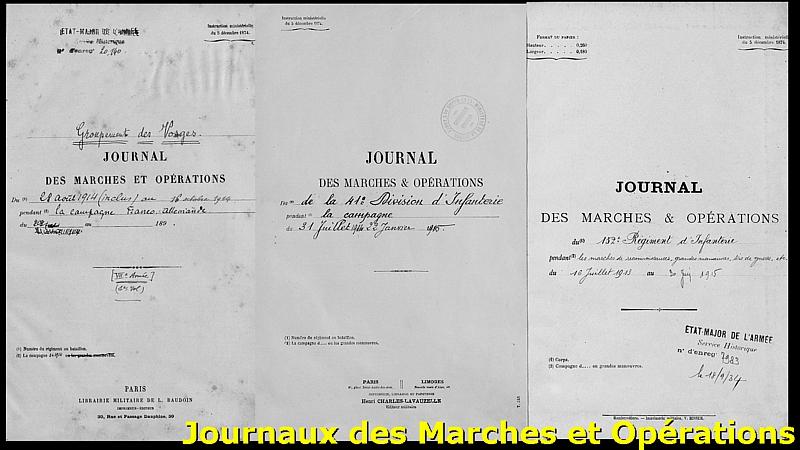
While continuously checking places and dates in other sources than those of Mack, like the French "Journaux des Marches et Opérations" and other even more reliable German sources, like Hauptmann Goes and others, I have come to the conclusion that the confusing writings of Mack are not completely reliable. With this qualification, Mack nevertheless is a good source when looking for the initial problems of the regiment.
(For a list of sources I would like to direct you to the list at the end of this lecture.)
Composition of the regiment

The 123rd Landwehr Regiment is a "Ban II Landwehr Regiment". That is the reason why the average age of officers and soldiers lies between 32 and 39 years. So, here we are dealing with men, who probably are fathers of families and who have honourable trades or professions. Except for some noble officers, this regiment mainly consists of artisans, farmers, businessmen, teachers, and other breadwinners.

The men originate from the garrison towns of the regiment, from Ulm and Ravensburg, but also from the surrounding towns and villages.
The 123rd consists of 3 battalions. The regimental staff and “I. Bataillon” are located in Ulm. The “II.” and “III. Bataillon” are garrisoned in Ravensburg. Each battalion has 4 companies and its own machine gun company.
4 August 1914 - The French opponent
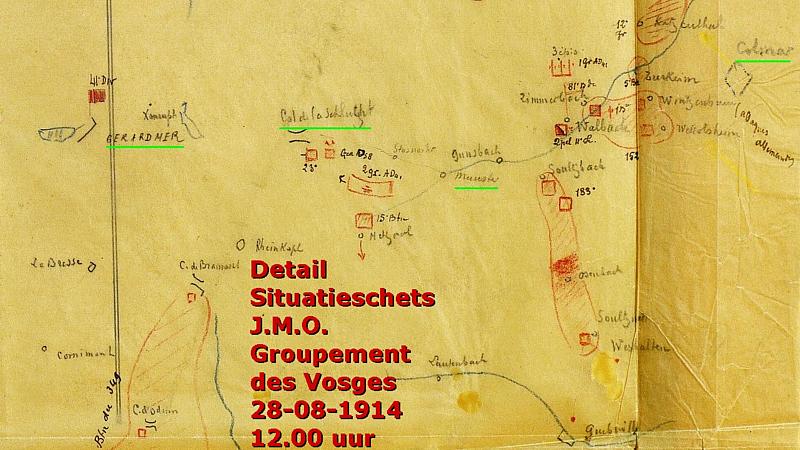
On 4 August, a strong French army force crosses the border posts on the mountain passes in the Vosges. The combat units of the “41e Division d’Infanterie” cross the border at the Col de la Schlucht. These troops successfully fight their way eastward to Munster and then towards the direction of Colmar. Besides infantry regiments, such as the famous “152e Régiment d’Infanterie” from Gérardmer, also several "Bataillons Chasseurs Alpins" march forward.

Here I need to emphasize that the French opponents are much better trained for mountainous terrain than the men of the "Landwehr". The "Chasseurs Alpins" especially are very well used to these environments, and they are very well trained. With their small mountain cannons and rapidly manoeuvrable machine gun teams, the Chasseurs are formidable opponents. According to Mack, they are able to camouflage themselves “in baskets of pine branches” , and to hide high in the trees. The superiority of French mountain troops has significance later in this story.
Mobilization in Ravensburg and Ulm
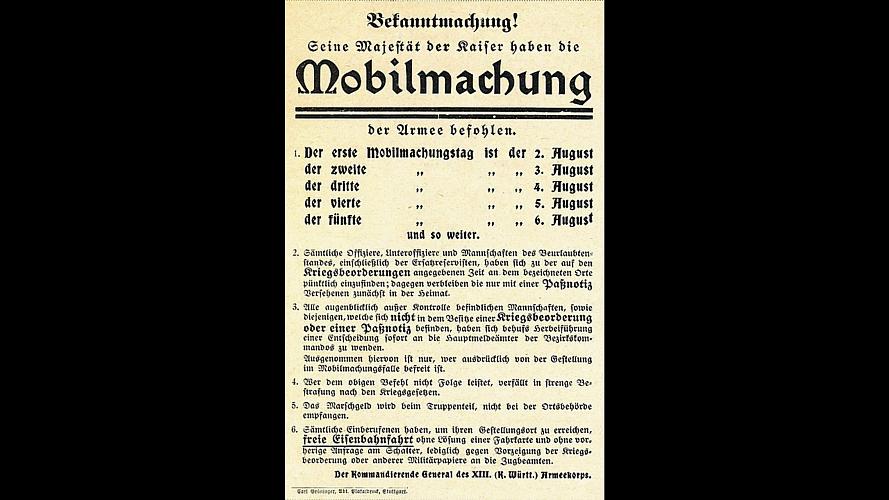
If I am to believe Adjutant Mack, the mobilization of the regiment in Ulm and Ravensburg between 3 and 6 August created quite some commotion and organizational confusion. The men, who are suddenly and unexpectedly called from their peaceful civilian life, have some difficulty to adjust to military life again. While still in Ravensburg and Ulm the men are first equipped with the obsolete "Gewehr 88". ( Rifle Model 1888 )
Lack of "feldgraue" uniforms
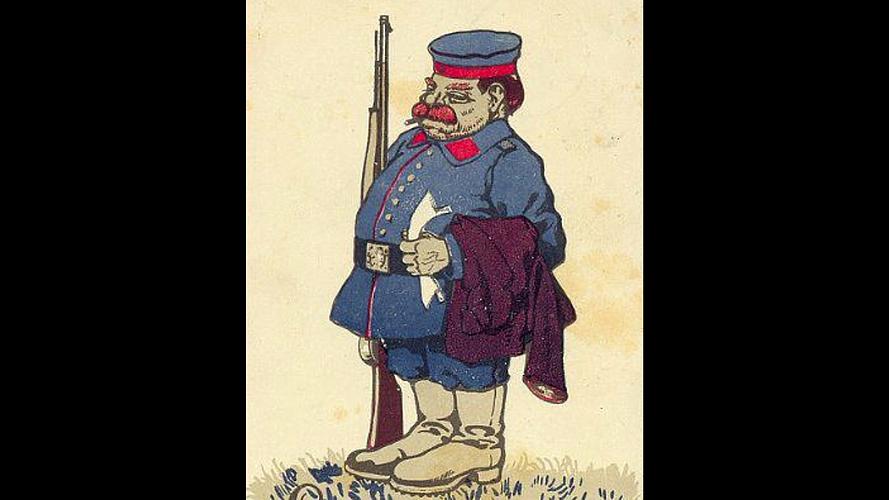
During these hectic days of mobilization there exists a great lack of "feldgraue" uniforms. Therefore both NCOs and men still are dressed in their blue, peacetime uniforms. Later on the II. Bataillon will pay dearly for wearing this blue uniform.
The human condition of "Pfarrer" Barthels

In Ravensburg a certain Pastor Barthels uses the general confusion and he volunteers, seemingly spontaneously, as the regimental almoner.
Later, after arriving in the field positions, Pastor Bathels will take a curious position on the use of alcohol among the troops. In daytime he performs a real crusade against the alcoholic gifts that were sent in abundantly -, especially during the first period of the war, - by wives and family.
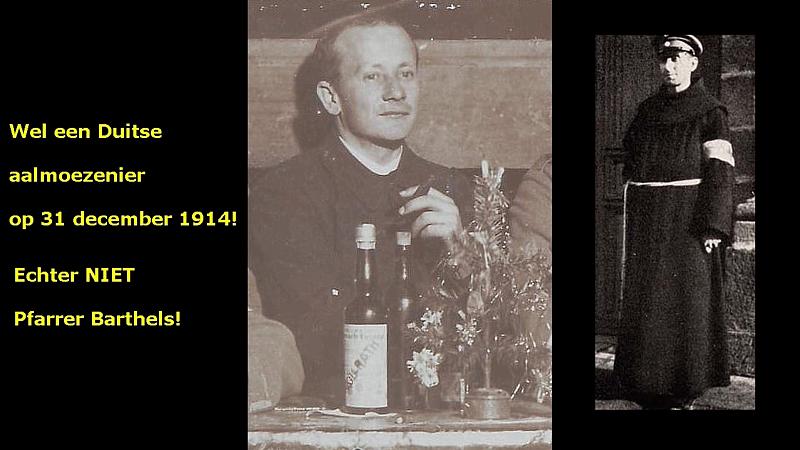
But at night, in his own "little room", Pfarrer Barthels drinks all the bottles of seized schnapps himself. Later on Pfarrer Barthels turns out to be a charlatan and not a real priest at all. He will therefore be "sufficiently punished" .
To the "Festung Neubreisach"
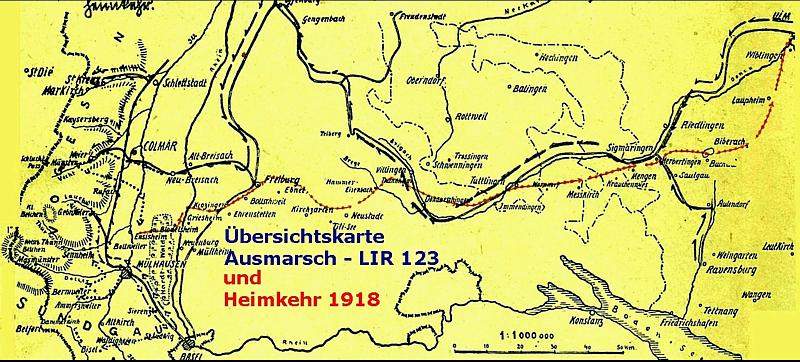
On 7 August the regiment sets off from Ulm and Ravensburg by train westward to the German town Neubreisach, in French Neuf-Brisach, south-east of Colmar. The men are excited, ready for war. Graffiti artists of the regiment have painted with chalk on the wagons slogans such as: "Franzosen, Russen, Serben, alle müssen sterben" (French, Russians and Serbs all must die) and "Ruẞland ist das schönste Land auf Erden, es muẞ nun doch noch badisch werden" (Russia is the most beautiful land on earth, now it is time to make it to belong to Baden). On 8 August all battalions arrive by train, and then go the last few miles on foot, at the "Festung Neubreisach".
“Gewehr 98”

In Neubreisach the men received long overdue instruction and training in the use of the "Gewehr 98", which most of them receive as the new standard weapon. The rest still hold on to the old "Gewehr 88". One does not need to be a weapons expert to see on the sketches above, that a soldier was significantly better off with the new model 98.
Constructing strongholds
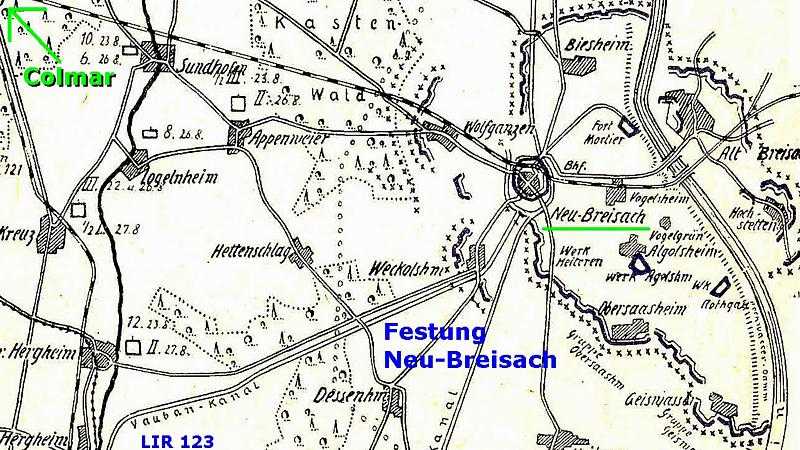
The Landwehr Infanterie Regiment 121 is also garrisoned in the Festung Neubreisach. From 14 to 25 August the two regiments receive orders to slow down the advance of the French army as long as possible, to conceal the weakness and the undermanned presence of the Germans as much as possible, and also to strengthen the fortifications of the weak Festung Neubreisach.
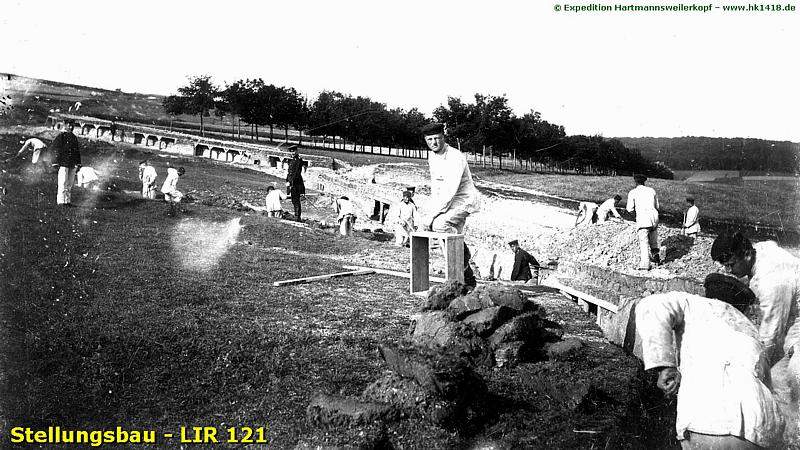
The II. Bataillon makes an exception. On 18 August it is added to the 1. Bayerische Landwehr Brigade and stationed in Logelbach, just outside and west of Colmar. As a temporary part of the brigade this battalion will soon undergo its baptism of fire. At that moment the defects of the regiment will become painfully obvious and it will meet several problems.
Baptism of fire at Gunsbach and Whir-au-Val
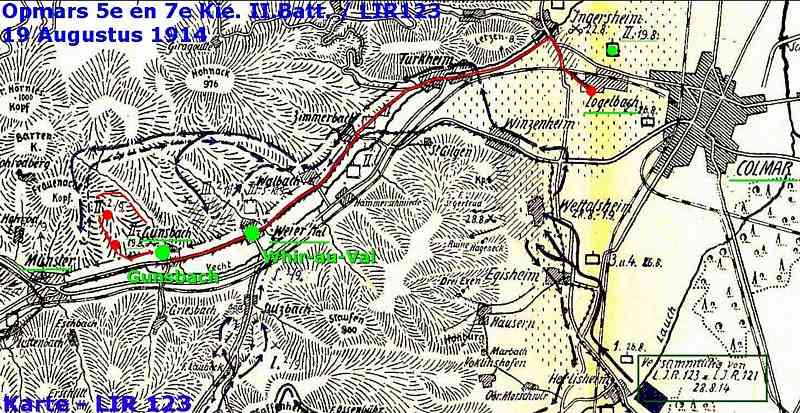
On 19 August the II. Bataillon, following the 121st Landwehr, marches through the Munster valley south-westward to Wihr-au-Val. From there the 5th and 7th company move through the village of Gunsbach, east of Munster, and spread out over the rolling fields beyond.
As the men of the 5th Kompagnie prepare to install themselves securely on the Heidenruckenkopf (682 m.), west of and overlooking Gunsbach, …

… they receive infantry- and machinegun fire from higher up from "Chasseurs Alpins". According to Mack these Chasseurs are "hidden in terraced, superposed and well positioned trenches" .
The 7th company tries to move from Gunsbach west through the valley, but just when they leave the village, they are met with heavy machinegun fire from units of the famous Red Devils regiment, the 152nd "Régiment d’Infanterie".
Friendly fire
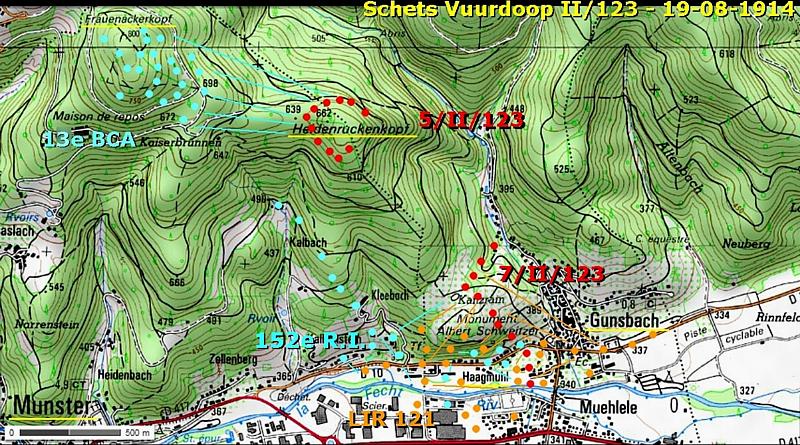
In the confusion, the company is not able to determine where the sure-fire enemy is hiding.
The units of the 121st Landwehr and the Bavarian Landwehr units have all been equipped with "field gray" uniforms. This has caused the Bavarian troops to confuse the blue-clad soldiers of the II. Battalion of the 123rd with the equally blue-wearing Chasseurs Alpins. From the sides and in the rear the Bavarian soldiers fire on their brothers in arms. That day the II. Bataillon loses 5 dead and 31 wounded, mainly by friendly fire. These figures include the Hauptmann of the 7th company.
No cover
It appears that on this day the battalion still lacks the necessary experience in the proper use of the terrain. The mountainous terrain has thick forests on the peaks, and lower down, the slopes are covered with vineyards with two metre high vines. Trees and vines constantly obstruct a clear view to comrades and to the French enemy. Partly because of these landscape features, communication with other combat units becomes complicated.
On the Heidenrückenkopf the situation has been the most distressing; lacking combat experience, these men have no idea how to go under cover, and cannot tell where their comrades are.
22 August 1914 - Combats at Logelbach and Ingersheim
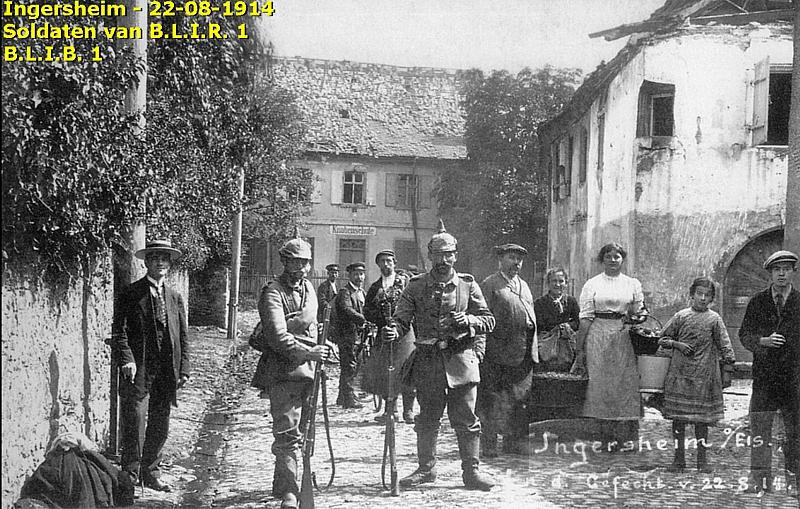
The same problems are experienced on 22 August during the infamous combats at Logelbach, in the streets of Ingersheim and in the surrounding vineyards. There too, the Bavarian “Landwehr Infanterie Regiment 1” gets confused and it unloads its friendly fire on the blue Württemberger.
Training in the use of grenades
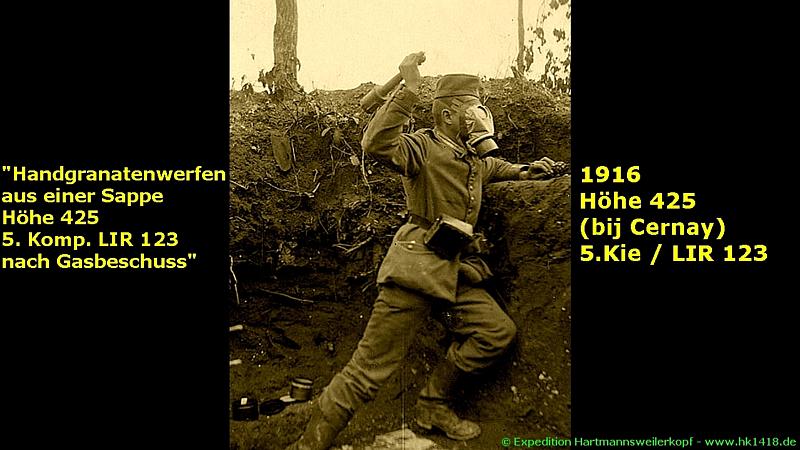
While the II. Bataillon receives its baptism of fire at Gunsbach and Whir-au-Val, the other two battalions of the 123rd experience a relatively quiet period. The I. Bataillon even has time for additional training. On 16 August the battalion gets for the first time instruction in the use of hand grenades. Presumably through inexperience a Lieutenant of 3rd Kompagnie is seriously injured.
The defence of Colmar
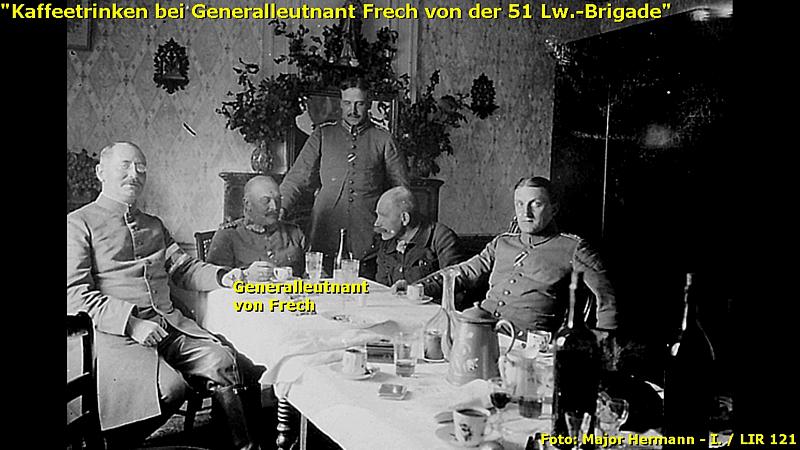
On 26 august General Gaede orders Generalleutenant Von Frech to force the French out of the valley of Munster with his "ad hoc Landwehr Brigade", which is named after him. Supported by two artillery batteries, some extra machine gun companies, and by the 121st Landwehr, which was temporarily added to the brigade, on 27 August the three battalions of the 123rd move to Colmar, Equisheim, Saint Croix and Herlisheim.
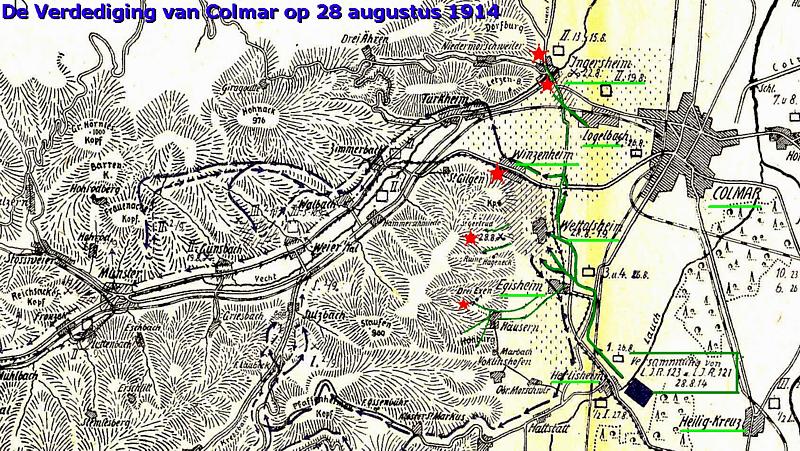
On 28 August at 01:00 a.m., the regiment is alerted to deal with units of the French 152nd in Wettolsheim and Wintzenheim. The advance through the valley goes well, but the advance of the 9th Kompagnie on the left flank on the slopes, intended to cover the progress of the troops in the valley, is slowed down by rain. In the dark and on the wet slopes in the vineyards, the company loses contact with the other units.
Poor communication

The official regimental history of the 121st Landwehr offers good example of the lack of good communication in the “Brigade von Frech”. The IV. Battalion of the 121st is already fully occupied fighting the French near Ingersheim. It is completely unaware of the onrushing auxiliaries of the 123rd and the subsequent arrival of the 5th and 7th Kompagnie. Even long afterward the chronicler of the 121st Landwehr is highly puzzled : "... while our line was frog-leaping forward, our IV. Bataillon was suddenly joined by the II. Battalion of the 123rd. God knows where they came from so suddenly!"
2 September 1914 - Combats at Whir-au-Val and Soultzbach
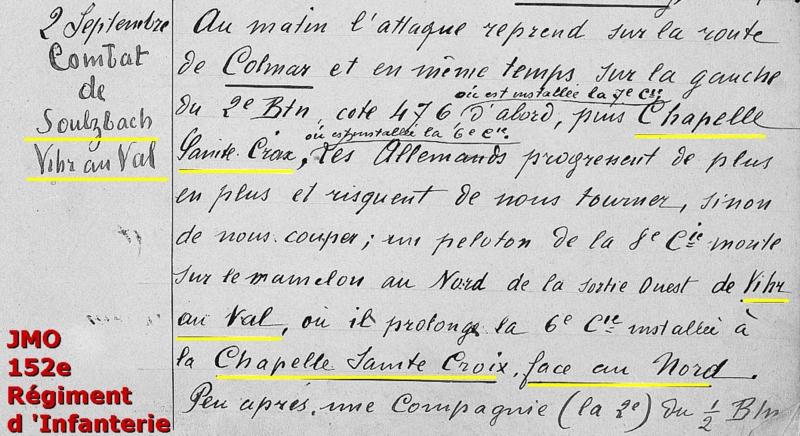
On 2 September the Brigade von Frech resumes the attack. As part of this brigade the regiment marches to Wihr-au-Val and Soultzbach.
General von Frech has devised an optimistic plan to attack the French there and to pin them down by an encirclement in the valley.

But, von Frech still does not take into account the difficult terrain with the steep slopes and dense woods. The communication problem is also unsolved. The Landwehr men lack combat experience to fight against a well-entrenched and barely visible enemy, this time the entire Red Devils infantry regiment, the 152nd!
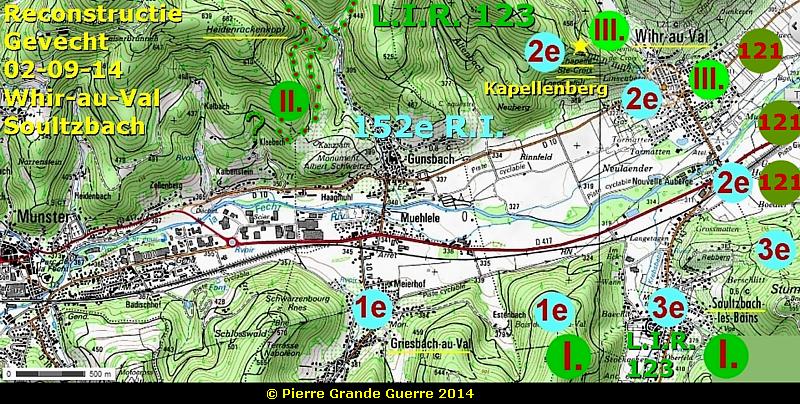
When the battalions arrive at their assigned locations, the plan immediately falls apart.
The II. Battalion does not reach its designated target at all. It loses its way even before reaching the Heidenruckenkopf, because of an officer with "bad vision" and a poor map with a scale of 1:100,000. After wandering around for a while, the II. Battalion decides to withdraw.
The I. Battalion endures heavy opposition at Soultzbach and after a couple of hours it is forced to cease fighting.
The III. Battalion receives heavy artillery and machine gun fire on the Kapellenberg just over Wihr-au-Val, which brings their progress to a halt. Once again confusion sets in and the men are unable to find adequate cover against the murderous rifle- and artillery fire.
No medical aid - no stretchers

The forced retreat of the III. Bataillon over the mountain slopes down to Wintzenheim is extremely difficult, especially because there is no medical assistance present, and because stretchers had not been taken along up the Kapellenberg. The stretcher bearers are positioned in the valley with the 121st Landwehr, which meets heavy fire also.
The men of the III. Bataillon are therefore forced to improvise stretchers with tarpaulin, jackets and guns to bring their wounded comrades back over the slopes to Wintzenheim. They arrive there late that evening, exhausted and with heavy losses. By the way, the French 152nd also suffers that day heavy losses on the Kapellenberg.
13 September - Cernay and Guebwiller
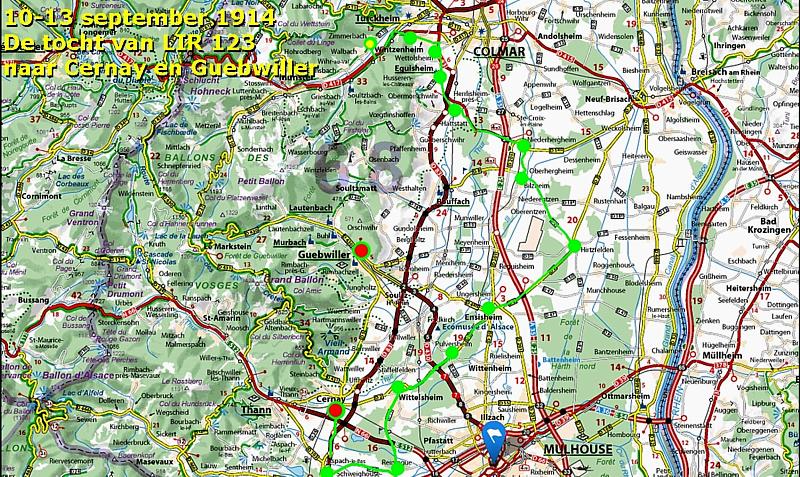
After several other battles with the French around Munster and under pressure from a new French attack on the Sundgau and Mulhouse, the 123rd departs from Munster to the south on 10 September. The arduous detour takes three days and on 13 September the regiment arrives at the locations in Cernay and Guebwiller, where it will stay until the end of the war.
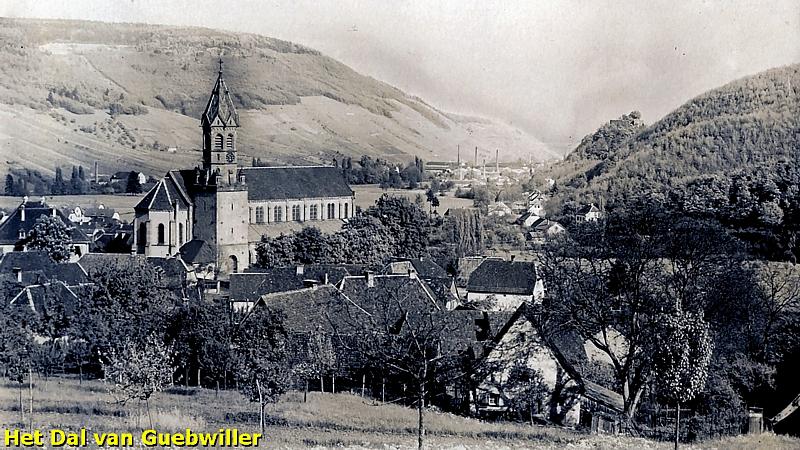
The declaration of mobilization, issued on 27 August in Stuttgart, reached the regiment officially only on that same 13th September day in Guebwiller.
On that same day also the blue clad 123rd regiment finally receives the “feldgrau" combat uniform!
While there, the Brigade Von Frech is officially renamed the "51. Gemischte Landwehr Brigade", provisionally composed of the 123rd and the “Landwehr Infanterie Regiment 119”. The Brigade forms a part of the “7. Württemberg Landwehr Infanterie Division”.
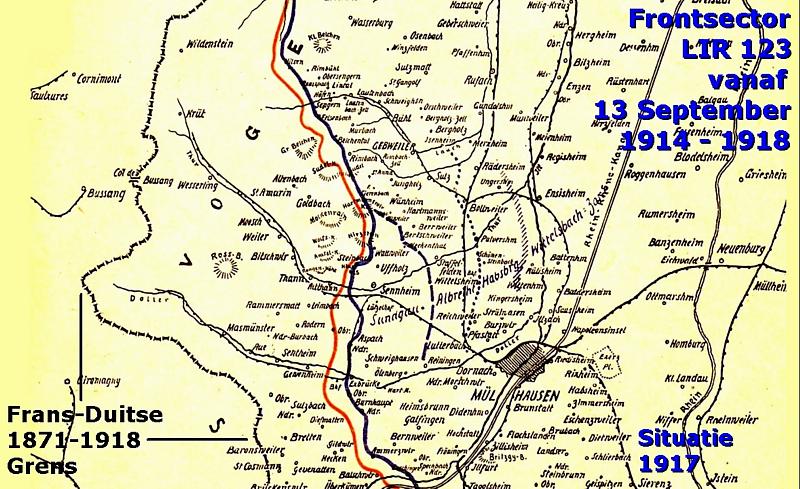
The Brigade is instructed to defend a mountain front from Wasserburg and the Petit Ballon in the north, through the valley of Guebwiller to the south, to the Hartmannswillerkopf and to Hill 425 near Cernay, just north of Mulhouse.
Occupying strategic points
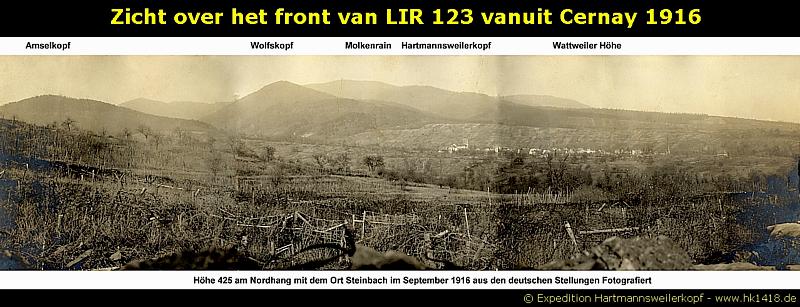
In September 1914 there is in the Vosges region not yet a situation of static war with trenches. The 123rd possesses too few men to defend their sector of the mountain front. Therefore the regiment limits itself initially to occupying the main strategic points in the valleys such as roads, intersections and villages. On the mountain peaks and slopes, which still seemed to be in German possession, the regiment constructs outposts and shelters.
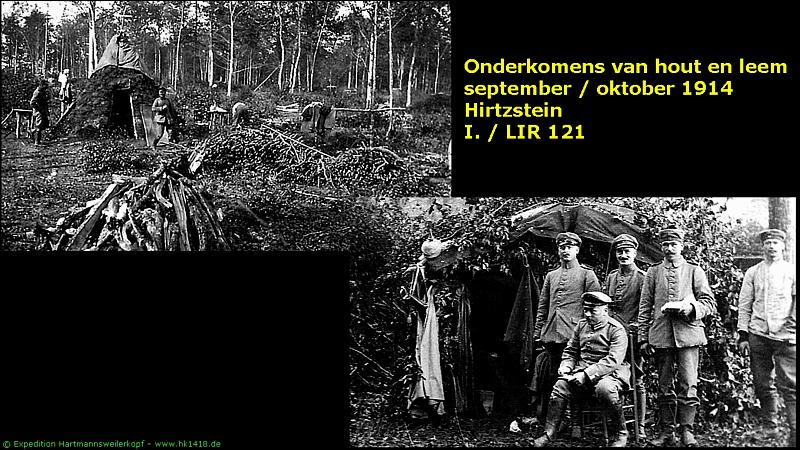
Mack gives no details, but the shelters in those days are almost worthless. In this early period of the war, they do not build concrete bunkers on the front, since that front had not yet stabilized. At best the men construct a log cabin. But, as I discovered in a photo collection of the 121st Landwehr, usually those first shelters were no more than primitive huts of wood, canvas and clay.
Mountain Guerilla
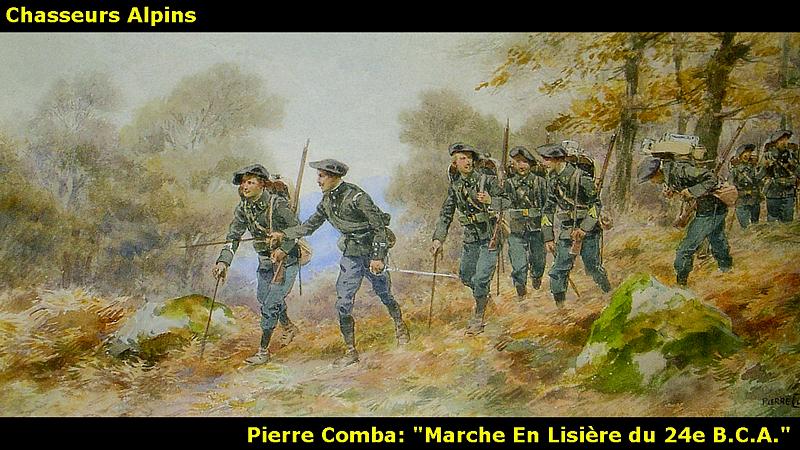
The frontline around Guebwiller and Cernay will be far from stable until the winter of 1915-1916. The French will infiltrate this German region for a long time. The mountain front of the 123rd between Wasserburg and Cernay in September and October is no serried front, and it is characterized by the many gaps on the mountain summits.
On the situation in those months our chronicler Mack makes a telling remark: "Es war reiner Guerilla, den man im Gebirge führte" (It was pure guerrilla, which one fought in the mountains). Many skirmishes take place but also larger battles with casualties on both sides.
Constantly, Mack complains indignantly about so-called tree shots. According to him, the Chasseurs Alpins snipers hide high up in trees and they make victims on a regular basis.
Patrols
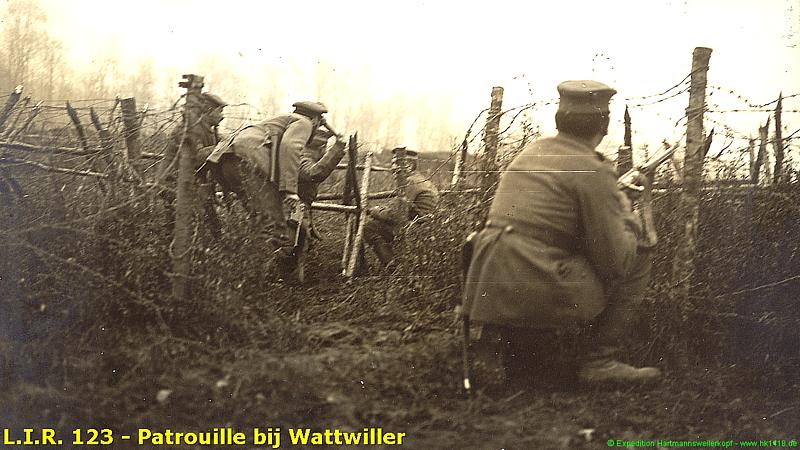
Both belligerent parties send out patrols to the mountains. Besides reconnaissance these patrols are also meant to take prisoners of war, hoping that those prisoners might be able to provide more detailed information about the identity and strength of the enemy forces; and perhaps knowledge of possible attack plans.
In order to keep some control over this region and especially to "purify" the valleys around Guebwiller and Cernay, the 123rd constantly sends out patrols, which often lead to small fights with French outposts, each with varying degrees of success. The size of these patrols varies: 30, 50 or 70 men.
On the other side the Chasseurs Alpins of the “66e Division de Réserve” execute reconnaissance raids on outposts of the Germans in groups of 70 to 100 men.
Inadequate maps
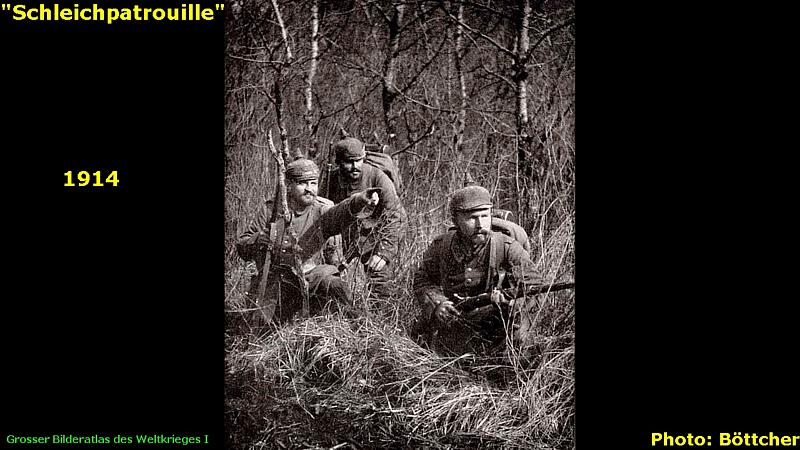
Again defects surface during the patrols of the 123rd. Most patrols are equipped with only one compass and they set off without a map. And when a map is available, it has a scale of 1:100,000. Anyone, who has ever walked in the Vosges, knows that with such a map it is virtually impossible to orientate yourself. Equipped with such an unsuitable map the patrols of the 123rd therefore lost their way regularly. Only by late November 1914 did the regiment gradually get access to better maps with a scale of 1:50,000, but by the standards of today this would still not be a good military map.
Construction of the first trench lines
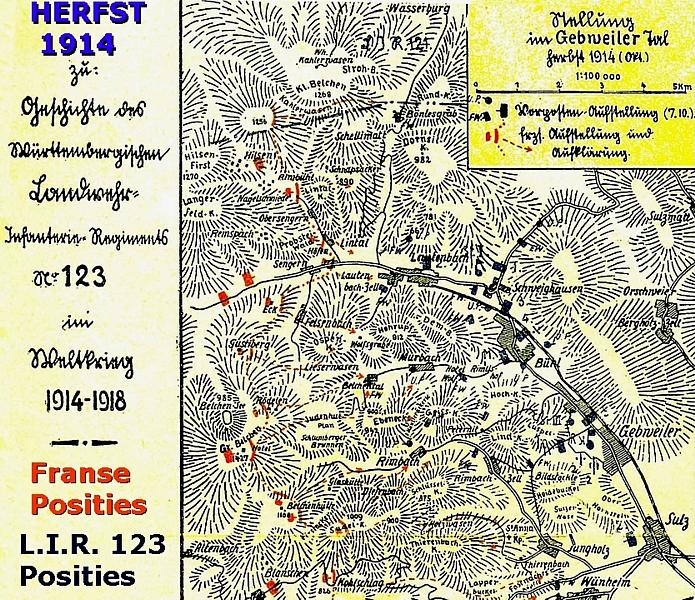
On 15 September the I. Bataillon gets it orders to dig a line of trenches in the sector of Lautenbach and Schweighouse.
The II. Bataillon creates a similar line from Soultz on the slopes of the Sudel, Kohlschlag and Freundstein.
The III. Bataillon creates a line from Rimbach in the valley of the Grand Ballon and on the summits of the Glasshütte and Judenhut. The villages Schweighouse, Bühl and the town of Guebwiller are converted into fortresses. The first outlines of the consolidated frontline become gradually visible.
8 October 1914 - Fighting spirit during a royal visit
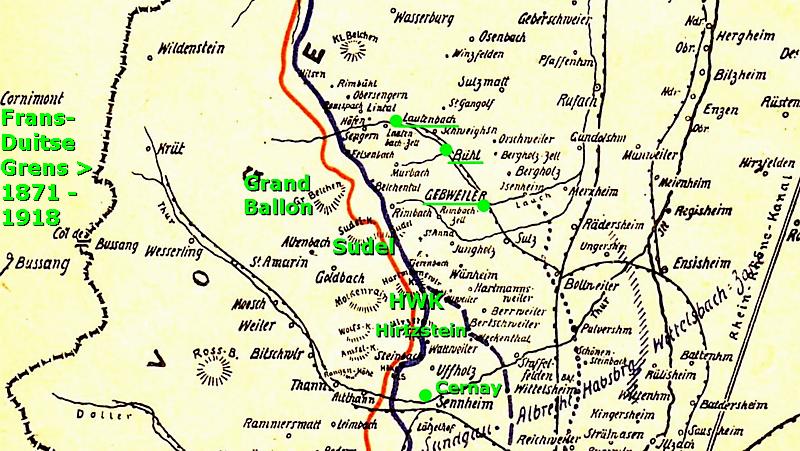
Despite all the initial problems this regiment exhibits the military virtues of good motivation and excellent fighting spirit. A fine example of this spirit takes place during an unexpected royal visit.
With the exception of 2nd Kompagnie, which had to guard the outposts at Lautenbach together with a machine gun platoon, the entire 1. Bataillon is summoned on 8 October to appear in Bühl on the northern edge of Guebwiller. The entire regimental staff is also present. All polished and shiny the battalion stands ready in a square formation at about 1.00 p.m. to await a long-kept secret visit of King Wilhelm II of Württemberg.
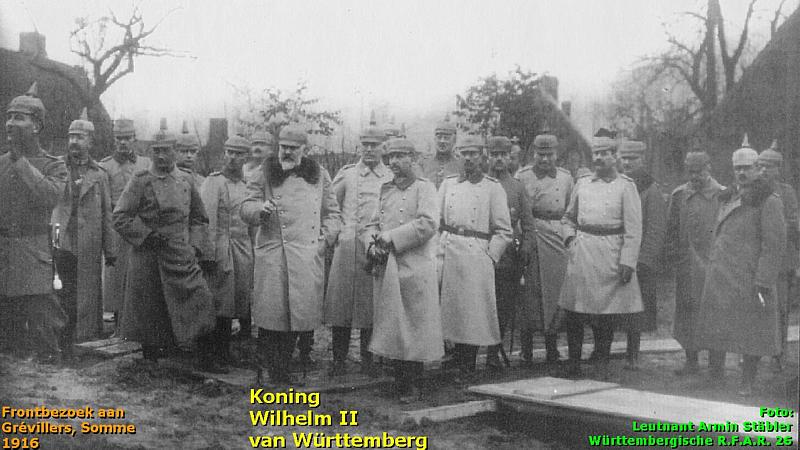
Unfortunately, at the same time that the king arrives, the French artillery spoils the occasion and bombards the outposts near Lautenbach. Forty-five minutes later, French infantry and Chasseurs attack that same location.
Alarmed by the audible and visible fire from the direction of Lautenbach the troops leave the square of Bühl immediately and run to assist in the defence of the positions under attack.
A small number of officers and a company of men remain in Bühl to receive the king properly. Immediately after his arrival the king uses this opportunity to view the fighting from a safe distance. When after one and a half hour the French attack has been repulsed successfully, the troops return hastily to Bühl to catch a glimpse of their King. The king, however, has already departed, leaving behind some thirty medals, most of which were intended for members of the 2. Kompagnie.
Fear for espionage
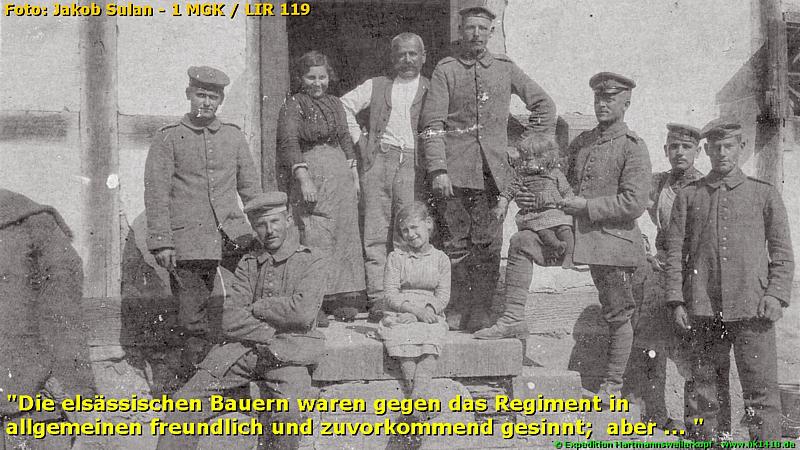
Mack suspects that the French knew in advance of the impending royal visit through espionage or by treason. The regiment is constantly on guard for signs of espionage.
The Württembergers do not trust the inhabitants of the Vosges. According to Mack the farmers can be trusted to a certain extent, " but the factory labourers from the villages in the valleys, being potential socialists, should be regarded as unreliable.” Also the Catholic Church is considered to be pro-French.
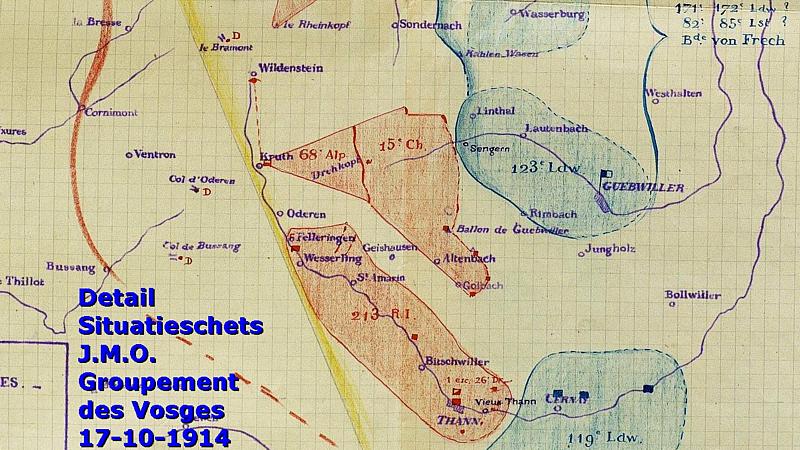
Mack illustrates his suspicion with an anecdote: A French artillery officer, a certain Brun, is spying, dressed in a German uniform, from the small village of Sengern the surroundings of Linthal. That German uniform forms his ill fate. On 13 October he is killed by a French outpost at Sengern, while still wearing the German uniform.
General Von Dinkelacker's "gewaltsame Erkundungen"
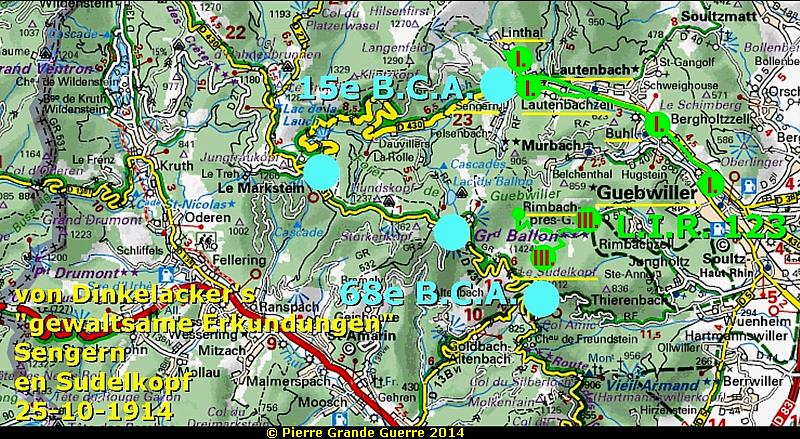
The arrival of the new brigade commander, General von Dinkelacker on 12 October causes a major change in tactics. Von Dinkelacker plans " gewaltsame Erkundungen ", (violent reconnaissance missions) with a much larger combat unit than that of a patrol.
On 25 October, after a brief preliminary artillery bombardment at 7.00 a.m., the 1. Bataillon opens the attack from Lautenbach on Sengern. At the same time the 3. Bataillon, accompanied by additional machine gun troops and Pioneers, starts a reconnaissance mission towards the Sudel.
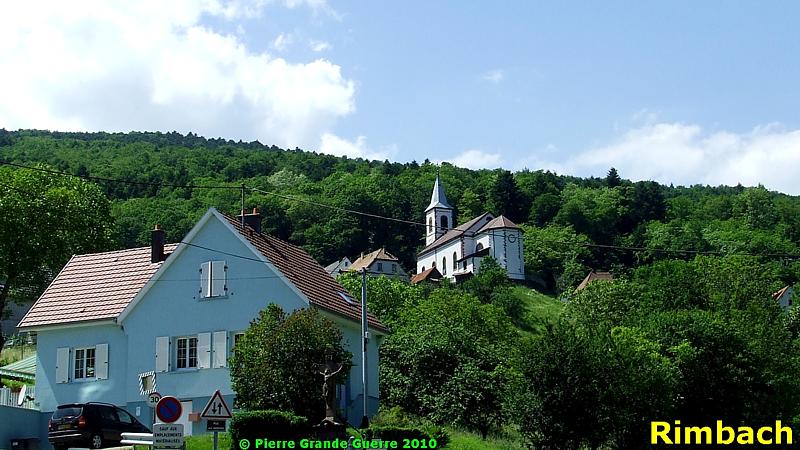
During the operation a number of fierce fire fights take place with two battalions of Chasseur Alpins, in which the Landwehr men frequently use hand grenades. The men received orders "to avoid serious fighting". Therefore, the fighting is sometimes halted merely 30 metres from the French positions.
Von Dinkelacker's violent reconnaissance operation succeeds only partially on the Sudel, but not at all in the north near Sengern. The regiment does, however, gain some necessary, additional combat experience.
November 1914
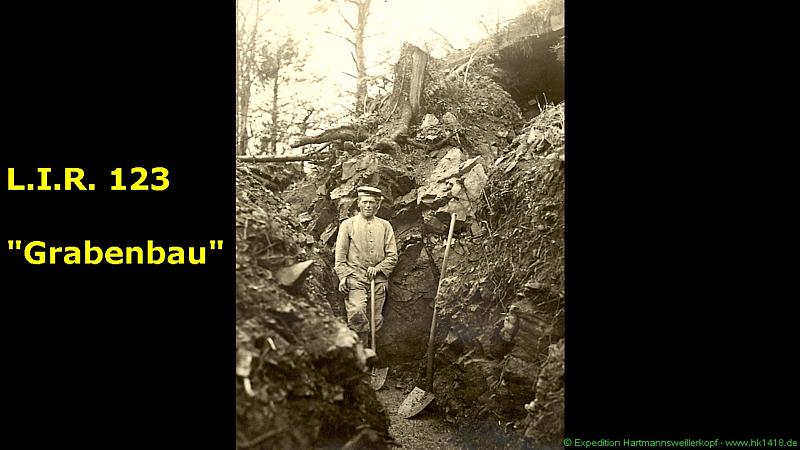
In late October the “Race to the Sea” ends, and all belligerent parties start to dig in for the future trench war along the now consolidated Western Front.
Besides the daily patrols and guard duties the 123rd is in November mainly concerned with building and improving defences and shelters. The shelters are still nothing near the later constructed deep concrete bunkers, but the troops are now starting to construct here and there log cabins with thick walls.
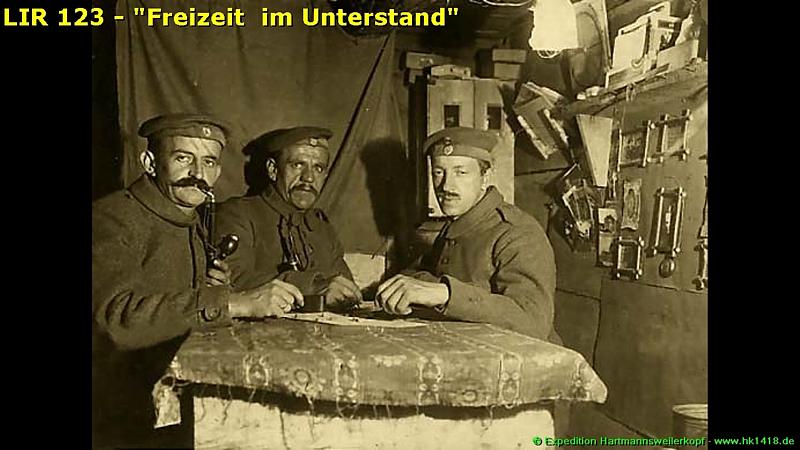
The fact that the Landwehr regiment possesses many experienced craftsmen in its ranks, accelerates the progress on the works on the structures. Keeping their motto in mind: "Schwäbischer Ordnungssinn zeigt sich im besten Lichte" (The Swabian sense of order reflects itself in the best light), the Landwehr men concentrate on the interior design of their new shelters. They construct stoves, kitchens, chairs and tables. A telephone is hung on the wall with a direct line to the company commander in Guebwiller.
In the meantime the regiment also gradually expands it defensive lines westward toward the eastern slopes of the Sudel, the Grand Ballon and the Petit Ballon.
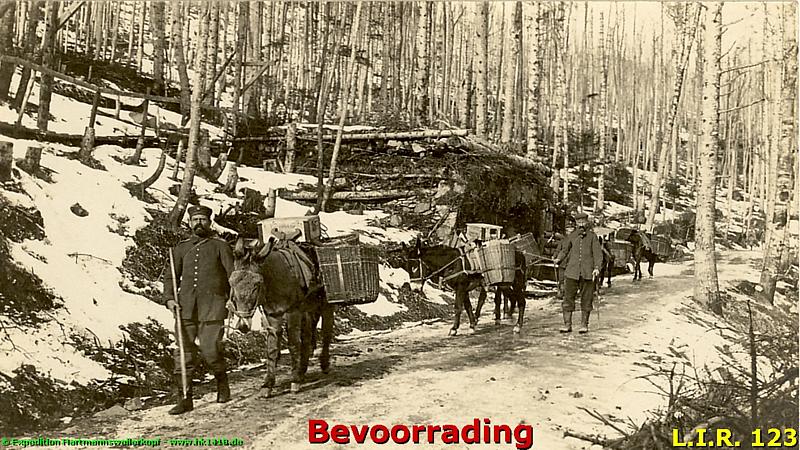
In November the Vosges winter starts early. The transport of building materials and other supplies from the Rimbach valley upward proves to be extremely difficult under the severe winter conditions. It takes at least 3 to 4 hours to carry simple supplies, like bread and coffee, up the slopes. Of course, the coffee is cold on arrival, if not frozen.
10 November - A French Raid on Rimbach
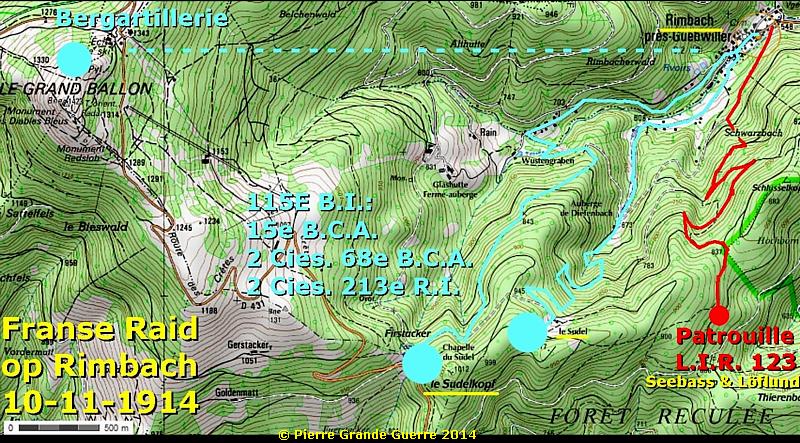
During November, the French also expand their patrol operations to larger units. These French combat units sometimes penetrate far into the German territory as in this example from 10 November in the village of Rimbach.
While the 123rd sends out a 110 man strong patrol along a southern route to explore the French positions on the Sudel, a French combat unit of the 115th Brigade, advances at the same time through the valley of Rimbach and it attacks the village. This unit consists of Chasseurs Alpins and two companies of the 213e Régiment d’Infanterie, reinforced on its flanks by units of 50 men equipped with machine guns. French mountain artillery on the Grand Ballon supports the attack and its shells set fire to a part of the village of Rimbach. The school, in which an officer post has been established, is destroyed by a direct hit.
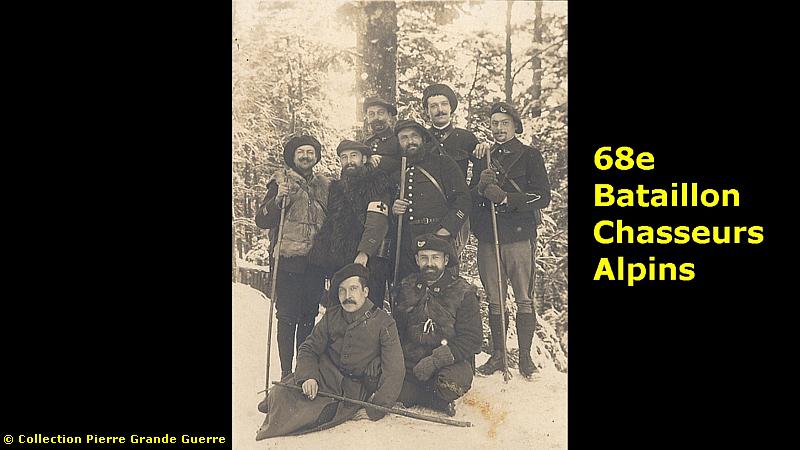
The Chasseurs manage to enter the village and search the houses one by one for German soldiers, but these soldiers have already left the village.
Alarmed by the nearby fire the German patrol immediately breaks off its reconnaissance mission and it descends to the valley. Together with onrushing soldiers from Jungholtz and Guebwiller the patrol recaptures the village of Rimbach and the soldiers push the French back to the Sudel.
December 1914 - French attacks and occupation of summits
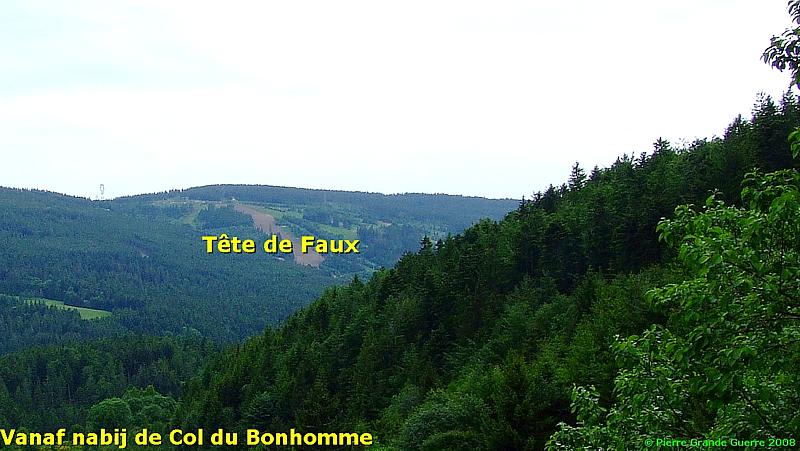
In early December, the "Groupement des Vosges" develops new and partly successful attacks and occupation actions on mountain summits, which neither side has yet occupied. These activities extend also into the more northern Vosges: On 19 December a French attack starts on the summit of the Tête de Faux, which will result about Christmas in a temporary French occupation of the summit for more than two months.
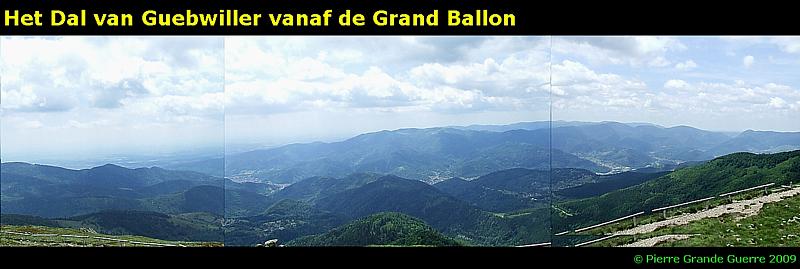
The 123rd Landwehr, which guards the front sector near Guebwiller and Cernay, becomes involved in these series of French attacks and occupation actions. On 2 December the French 68th Bataillon Chasseurs Alpins manages to occupy permanently the massif of the Molkenrain opposite the Hartmannswillerkopf and the Grand Ballon. These positions offer the French an unobstructed view and an open field of fire over the valley of Guebwiller.
Reinforcing defences
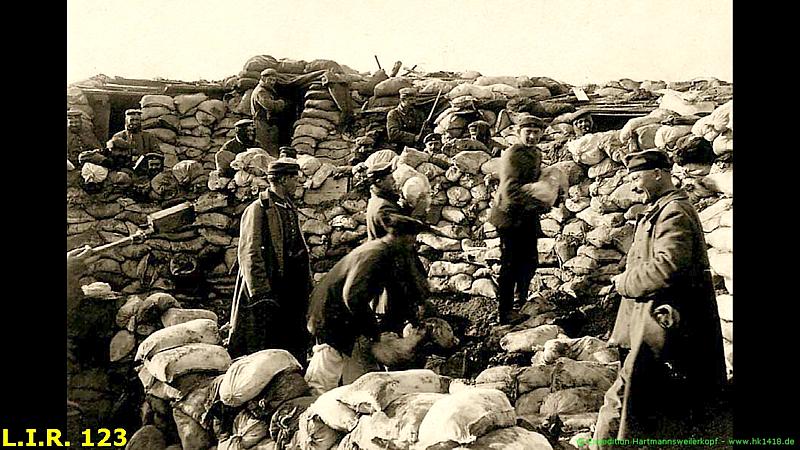
The changing situation of late November forces the regiment to make haste in reinforcing their defences to the south.
The troops are barely settled into their new positions, when the French launch their attacks on 1 December on Hill 425 and the valley around Cernay, and later that month at the Hartmannswillerkopf and the Hirzstein. The 123rd met its first peak in battle activity during the First Christmas Battle of Hartmannswillerkopf.
The First Christmas Battle of the Hartmannswillerkopf

I offer you a concise summary of this mountain battle. It is a harsh winter and the summits are covered with a layer of snow at least 60 centimetres deep. The regiment lights campfires along the slopes.
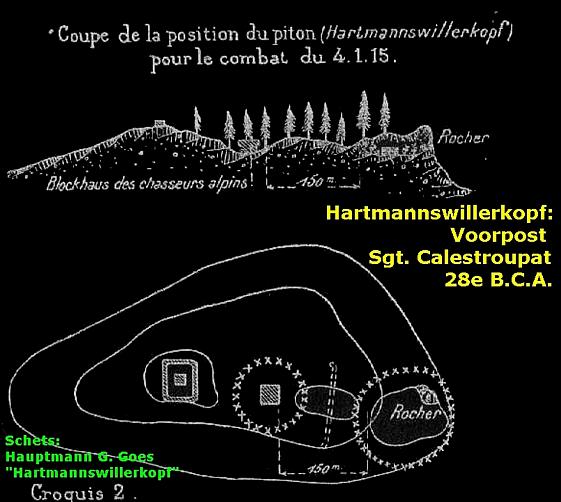
On Christmas Day 1914, a small unit of four men of the 28th Battalion of Chasseurs Alpins installs a small outpost on the Hartmannswillerkopf, a mere log cabin, 150 metres away from the western edge of the spherical top.
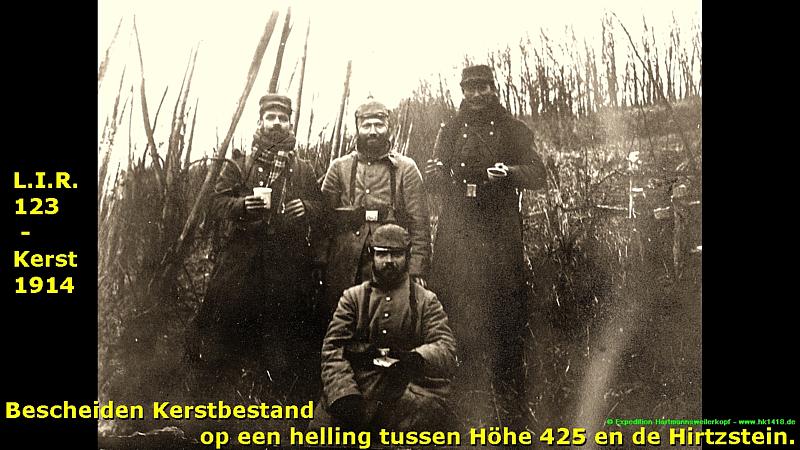
On Christmas Day, on a southern slope of the nearby Hirzstein, French infantry soldiers and some men of the 123rd agree upon a modest Christmas Truce. Mack does not report this fact but the photo collection of the 123rd supplies evidence of this event.
The next day, on 26 December, the Chasseurs on the Hartmannswillerkopf shoot at a unit of 43 men of the 123rd, who are preparing to settle on the eastern "Aussichtsfelsen" (Panorama Rock). Soon afterwards the German attacks concentrate on this French post, at first weak, but significantly intensifying over the next days.
Despite the temporary Christmas Truce other units of the 28th Bataillon Chasseurs occupied the quartz rock of the Hirzstein on Boxing Day.
"Sicherungsabschnitte"
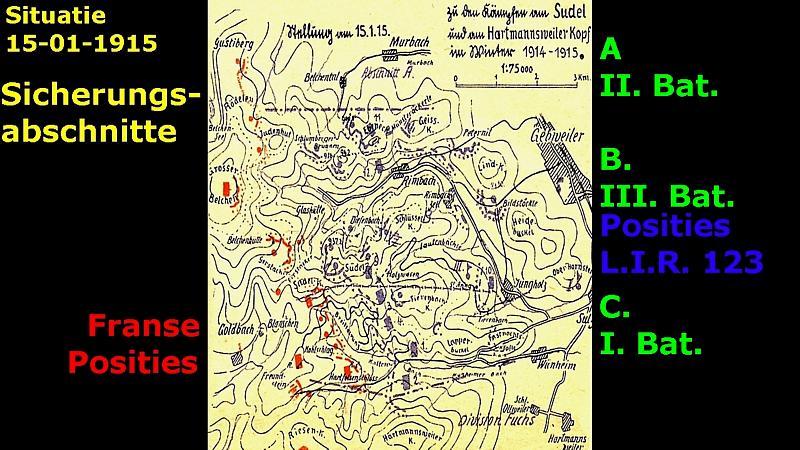
Under threat of these continuous French attacks and the occupation of several summits the German regimental staff decides to split its front sector into three "Sicherungsabschnitte", security sectors, defending these front sectors, called A, B, and C, each defended by its own battalion.
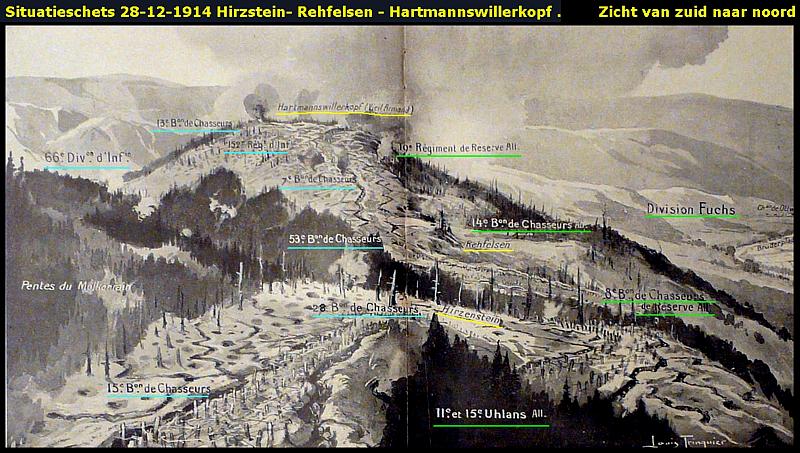
From 28 December the German 16th "Division Fuchs", with of course the 123rd exerts great effort to expel the "Chasseurs" from the summits of the Hartmannswillerkopf and the Hirzstein.
Ten days later, on 19 January 1915, the persistent presence of the French on these summits comes to a final end.
Heavy losses in the "Sicherungsabschnitte"
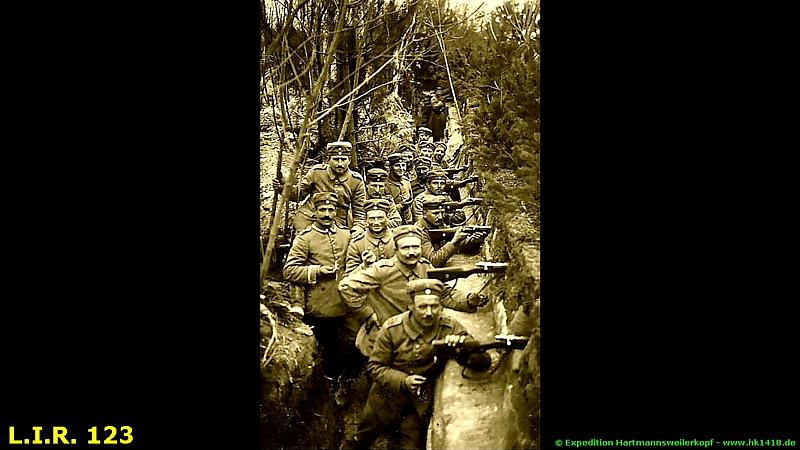
The 123rd contributes considerably to these battles on and around the Hartmannswillerkopf. From the first day of skirmishes with the French almost all companies of the 123rd suffer heavy losses in all three of their "Sicherungsabschnitte". The fighting in the southern security sector C, in the steep, wooded forests especially generates confusion and miscommunication among the troops.
On 4 January 1915, there is combat on the Hartmannswillerkopf between the 8. Kompagnie and a platoon of the 28th Battalion de Chasseurs. Without noticing at all the pack of Chasseurs in the woods the 8th Kompagnie advances rather carelessly to find themselves cut off and almost completely surrounded by the Chasseurs. Drawing fire from several sides the Kompagnie completely loses control of the fight. Anyone who can escape from this fight only manages to reach his lines late in the evening.
Major Sprandel killed
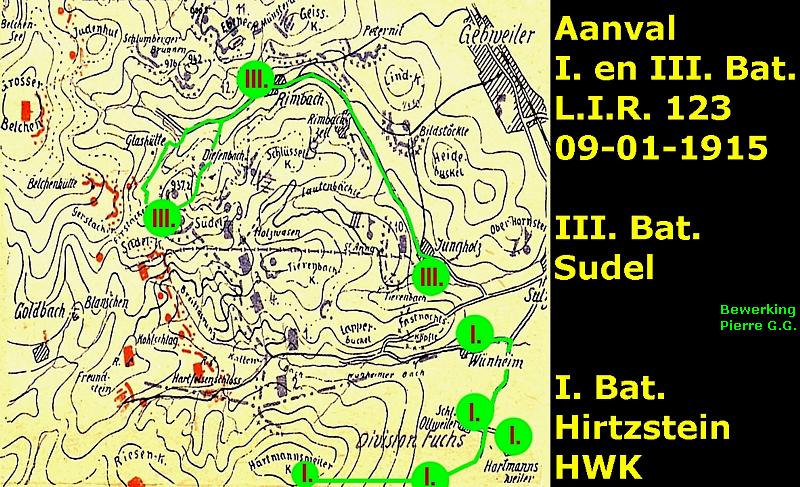
Assisted by a “facilitating” diversion attack of the III. Bataillon on Sudel, the I. Bataillon attacks the Hartmannswillerkopf and the Hirtzstein on 9 January. While III. Bataillon counts this day only two wounded, the I. Bataillon suffers heavy losses.
One could call it heroism or naive enthusiasm, but the fate of Major Sprandel stands out as an example for all the other officers and soldiers, who met death during this battle. "With his sword in his hand" Major Sprandel storms "bravely into battle" at the head of his I. Bataillon, when he is "hit in his eye by a deadly tree shot". When Sprandel dies twenty minutes later, Hauptmann Graf takes over command of the I. Bataillon.
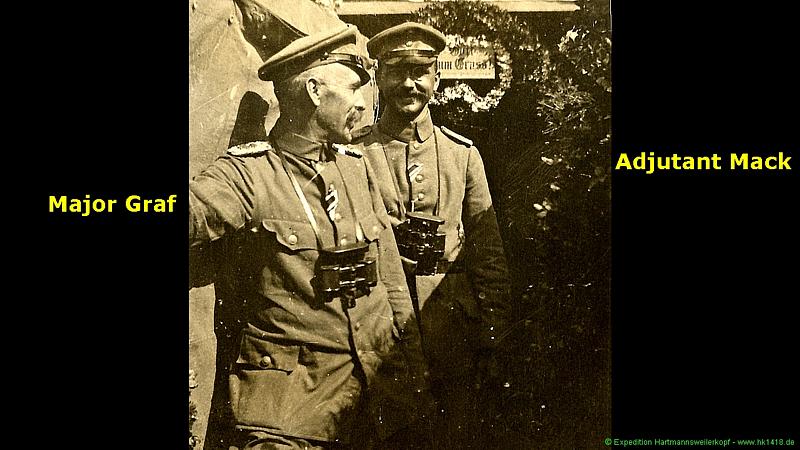
Mack is present and he later writes: "The superiority of firepower of the enemy could not be broken, not even with extra machine gun fire, and barbed wire obstacles were too strong and too deep and these prevented an attack with the bayonet (.....) The frozen ground offered no opportunity to dig in for cover.”
The I. Bataillon loses this day 2 officers and 35 men. Seven officers and 73 soldiers are injured.
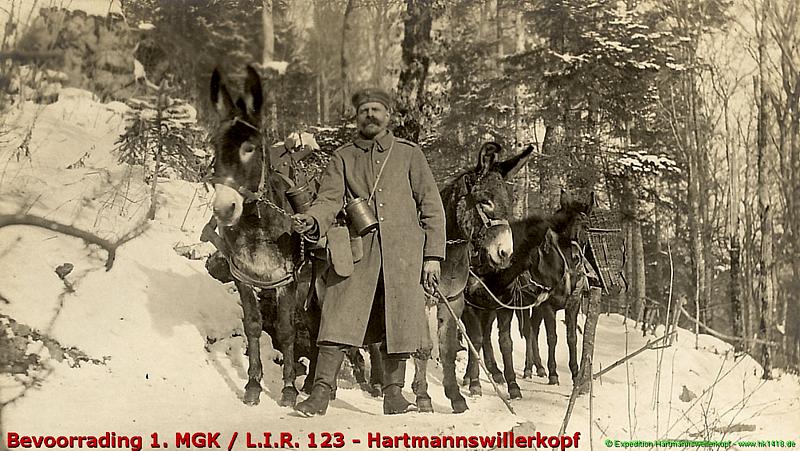
The German success of the First Christmas Battle of the Hartmannswillerkopf owed more to the other units of the Division Fuchs than to the long-suffering I. Bataillon and the rest of the regiment.
Improving Situation from February 1915
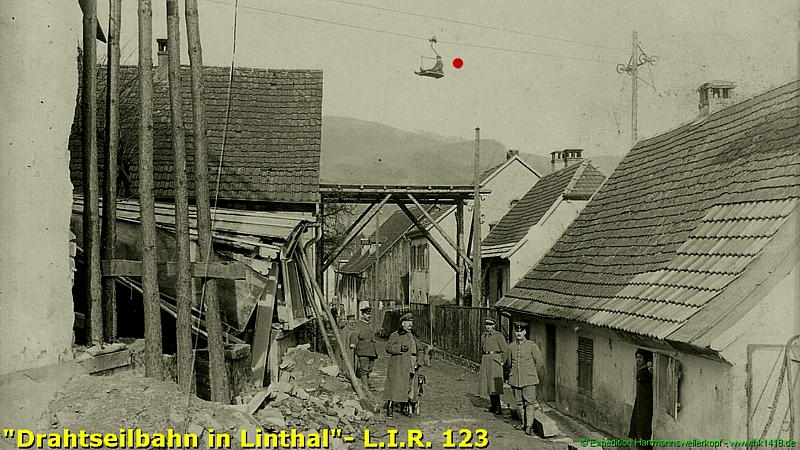
As stated earlier, until the end of the war the 123rd will stay in its positions and it will guard the front between Wasserburg and Cernay, as the "Wacht am Rhein". From February 1915 onwards the 123rd gradually solves even its last problems.
The laborious supply from the valley to the top will gradually improve by using more mules and by the construction of a network of narrow-gauge railways and cable cars.
The lack of combat experience also gradually disappears. At least until January 1916 the 123rd will be involved in all sorts of battles for the Sudel and in the Second Christmas Battle of the Hartmannswillerkopf. From 1915 the regiment also receives improved topographic maps. Medics and stretcher bearers will accompany the units. The regiment stays armed with often outdated weapons or captured material, such as Russian machine guns.
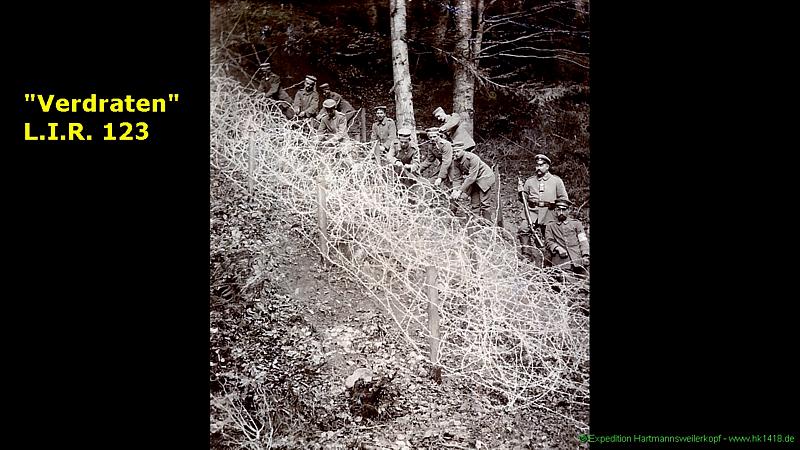
The 123rd will further perfect its positions with deep barbed wire obstacles, with high voltage wires (1500 Volt), and with well-built, stone-clad trenches and concrete bunkers of various types. Many of these bunkers provide access to shelters, deeply carved into the mountains and equipped with electricity.
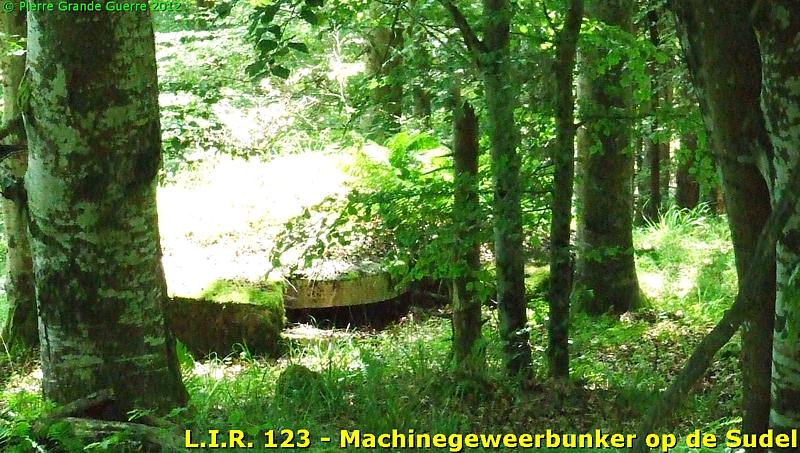
The concrete structures, which the regiment left behind after the war, can still be seen in villages like Rimbach and on the slopes and summits of the Hartmannswillerkopf and the Sudel.
Final
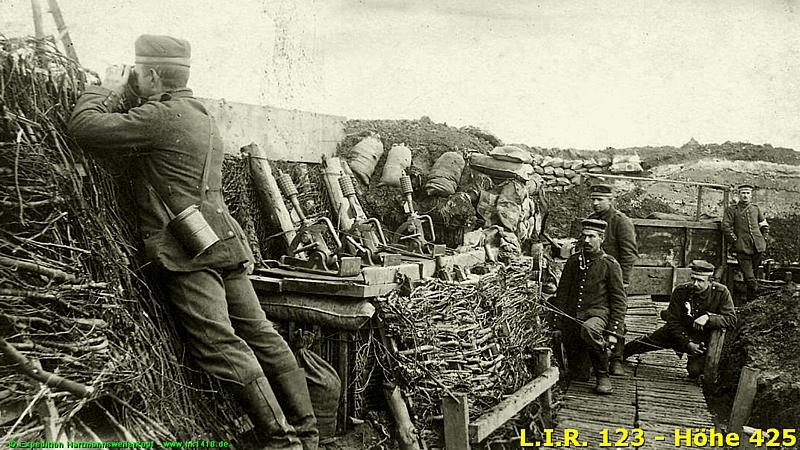
The Vosges is known, especially after January 1916, as a relatively quiet front. Yet, even after that period the Landwehr men will not escape from the horrors of war in the Vosges mountains. The harsh conditions of the local winters, the numerous artillery barrages, mine warfare, and man-to-man battles will cause the loss of numerous lives.
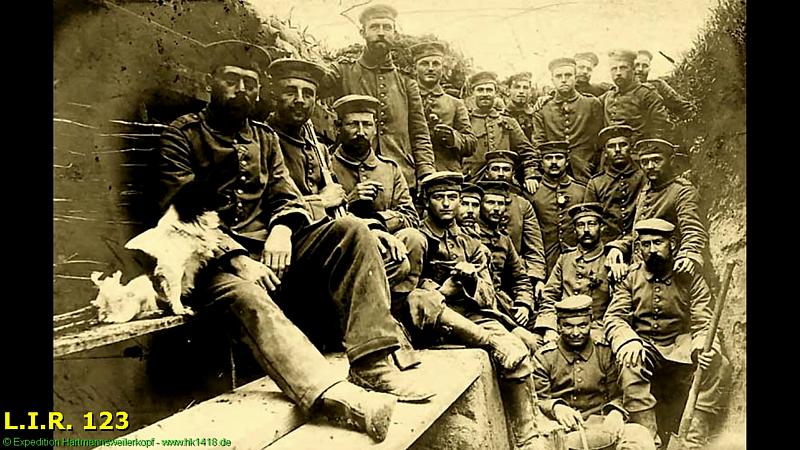
The creation of the "Wacht am Rhein" thus proved to be a slow and difficult learning process for the 123rd. From the beginning of this learning process until the dissolution of the regiment on 12 December 1918 the total casualty numbers are 78 officers and 1.862 soldiers.
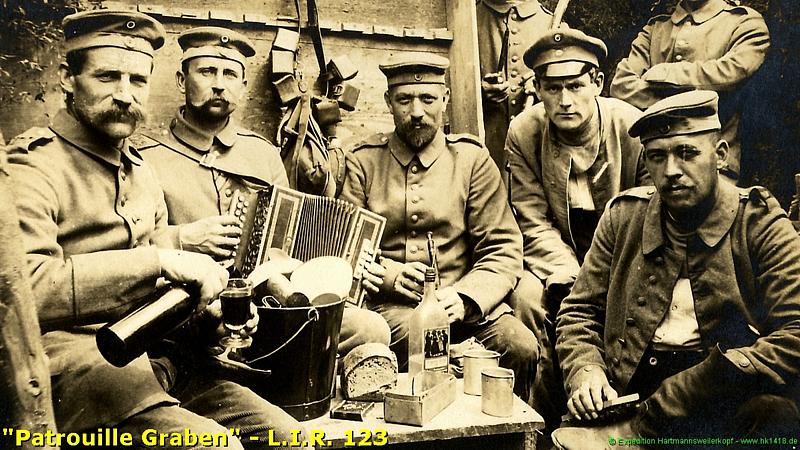
Of these men the regiment counts a total of 1.228 injured men. Two officers and 106 soldiers are still recorded as missing. Thirty-three officers were killed, most of them during the first six months of the war! Furthermore, during the four years of war 495 soldiers were killed.
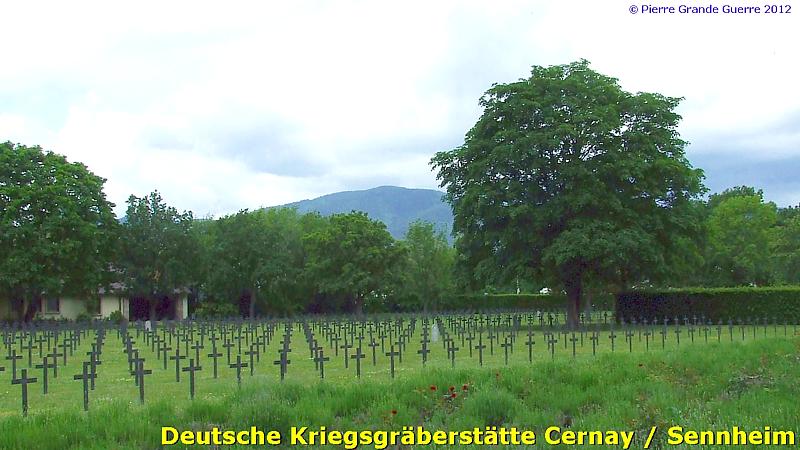
Some of these Württemberger artisans, farmers, businessmen, teachers, uncles and fathers have been given a grave in the "Deutsche Kriegsgräberstätte" in Cernay and Guebwiller at the foot of the Hartmannswillerkopf.
They still hold the "Wacht am Rhein", but nowadays on French territory within a united Europe.
I thank you for your kind attention,
Pierre Grande Guerre - 6 September 2014
| Sources |
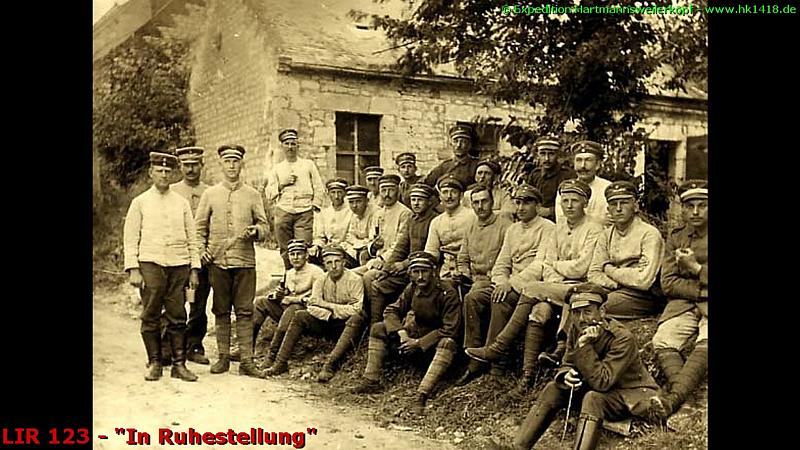
German Sources:
Prof. Dr. A. Mack: “Das Württembergische Landwehr Infanterie Regiment Nr. 123 im Weltkrieg 1914-1918” – Stuttgart, 1922.
Kurt Stein: “Das Württembergische Landwehr Infanterie Regiment Nr. 121 im Weltkrieg 1914-1918” – Stuttgart, 1925.
Mar Rösch: “Das Württembergische Landwehr Infanterie Regiment Nr. 119 im Weltkrieg 1914-1918” – Stuttgart, 1923.
Hauptmann C. Goes: “Hartmannswillerkopf” – 1922 (Franse vertaling)
Fotocollecties van het L.I.R. 119, L.I.R. 121 (Albums: Major Hermann en Jakob Sulan ), en L.I.R. 123,
gepubliceerd met toestemming van Detlef Bussat , Expedition Hartmannsweilerkopf – www.hk1418 .de.
French Sources:
Journaux des Marches et Opérations van de “Groupement des Vosges” (VIIe Corps d’Armée)
41e Division d’Infanterie
66e Division de Reserve
152e Régiment d’Infanterie
En de “Historiques de Bataillon” van het
12e Bataillon Chasseurs Alpins
15e Bataillon Chasseurs Alpins
28e Bataillon Chasseurs Alpins
68e Bataillon Chasseurs Alpins
Louis Scheromm: “Au Sudel en première ligne”
Pierre Marteaux: “Diables Rouges Diables Bleus à l’Hartmannswillerkopf”
Dutch Source:
Pierre Grande Guerre: “De Rode Duivels in de Vogezen – 1914-1915 – Een Geïllustreerde Reconstructie van de Krijgsverrichtingen van het 152e R.I.”
